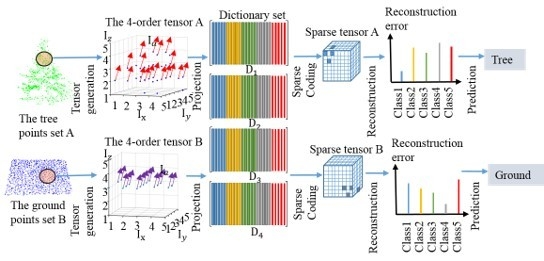Tensor-Based Sparse Representation Classification for Urban Airborne LiDAR Points
Abstract
:1. Introduction
- A new data structure is introduced to represent each point. To keep the feature description in their original geometrical 3D space, the LiDAR points are represented as 4th-order tensors. A point and its neighboring points are rearranged by their spatial distribution in the tensor space, meanwhile the features of each point in the neighborhood are also attached as the fouth mode of the tensor. In this tensor data structure, both spatial and feature information can be used for classification.
- A structured and discriminative dictionary set is learned for tensors based on a few samples of training data. Firstly, we present a structured and discriminative dictionary learning adapted to the high dimensional tensor data. Additionally, the dictionary learning only uses a few samples of training data. The dictionary classifier shows better classification ability than other popular classifiers (KNN, decision tree, random forest, SVM) when using the same amount of training data.
2. Tensor Representation of LiDAR Points
2.1. Tensor Notations and Preliminaries
2.2. Tensor Representation of LiDAR Point
3. Tensor-Based Sparse Representation Classification Methodology
3.1. Sparse Representation Classification Model
3.2. Tensor-Based Sparse Reperesntation Classification
3.2.1. Tensor-Based Sparse Coding
3.2.2. Structured and Discriminative Dictionary Learning
3.2.3. Tensor-Based Sparse Representation Classifier
4. Results
4.1. Data Description
4.2. Feature Extraction
4.2.1. Height-Based Features
- Height difference. Height difference is measured between the LiDAR point and the lowest point found in a multiple scale cylindrical neighborhood. By varying the size of the local cylindrical neighborhood, height differences are calculated for each scale. The cylinder radii have been set experimentally to 10 m and 2 m, and correspondingly the height differences are denoted by and . The height difference is given by:
4.2.2. Local Plane-Based Features
- 2–4.
- Normal vector: Normal X; Normal Y; and, Normal Z. The normal vectors of local planes are estimated by k neighbor points, normal X; normal Y; normal Z are the values in X, Y, Z direction from the normal vectors.
- 5.
- NormalSigma0: the standard deviation of normal estimation. The value is high in rough areas and low in smooth areas.
- 6.
- NormalZSigma0: the standard deviation of Normal Z estimation in a cylindrical neighborhood. The value can reflect the penetrability of the object.
- 7.
- Normal planeoffset: the offset between the current point and its local estimated plane.
- 8–10.
- Eigenvalues: Eigenvalue1; Eigenvalue2; and, Eigenvalue3. The covariance matrix used for the normal vector computation is decomposed by eigenvalue analysis. This yields ; . have low values for planar object and higher values for voluminous point clouds.
4.2.3. Echo-Based Features
- 11.
- Echo Ratio: The ER (echo ratio) is a measure for local transparency and roughness. It is defined as follows [30].with , is the number of neighbors found in a certain search distance measured in 3D and is the number of neighbors found in the same distance measured in two-dimensions (2D). The ER is nearly 100% for a flat surface, whereas the ER decreases for penetrable surface parts since there are more points in a vertical search cylinder than there are points in a sphere with the same radius.
- 12.
- Echo number ratio. The echo number ratio of each point is defined as:
4.2.4. Local Shape-Based Features
- 13–18.
- Linearity = ; Planarity = ; Sphericity =
4.3. Classification Results
4.3.1. Tensor-Based Sparse Representation Classification Results and Discussion
4.3.2. Classification Comparison
- KNN:
- the k nearest neighborhood points, distance computation function.
- DT:
- the minimum observations on each leaf, the minimum observations in each branch node, and the maximum number of branch node splits.
- RF:
- the number of predictors, and the parameters included for generating the decision tree, which contains the minimum observations on each leaf, the minimum observations in each branch node, and the maximum number of branch node splits.
- SVM:
- the kernel function, the kernel size and the box constraint which is the weight of cost of misclassification.
5. Discussion
5.1. Impact of Neighborhood Size Selection in Tensor Generation
5.2. Impact of Sparsity Level
5.3. Impact of Training Data
6. Conclusions
Acknowledgments
Author Contributions
Conflicts of Interest
References
- Secord, J.; Zakhor, A. Tree detection in urban regions using aerial lidar and image data. IEEE Geosci. Remote Sens. Lett. 2007, 4, 196–200. [Google Scholar] [CrossRef]
- Lodha, S.K.; Fitzpatrick, D.M.; Helmbold, D.P. Aerial lidar data classification using adaboost. In Proceedings of the Sixth International Conference on 3-D Digital Imaging and Modeling, Montreal, QC, Canada, 21–23 August 2007; pp. 435–442. [Google Scholar]
- Garcia-Gutierreza, J.; Gonçalves-Secob, L.; Riquelme-Santosa, J. Decision trees on lidar to classify land uses and covers. In Proceedings of the ISPRS Workshop: Laserscanning, Paris, France, 1–2 September 2009; pp. 323–328. [Google Scholar]
- Guo, L.; Chehata, N.; Mallet, C.; Boukir, S. Relevance of airborne lidar and multispectral image data for urban scene classification using random forests. ISPRS J. Photogramm. Remote Sens. 2011, 66, 56–66. [Google Scholar] [CrossRef]
- Najafi, M.; Namin, S.T.; Salzmann, M.; Petersson, L. Non-associative higher-order markov networks for point cloud classification. In Proceedings of the European Conference on Computer Vision, Zurich, Switzerland, 6–12 September 2014; Springer: Cham, Switzerland, 2014; pp. 500–515. [Google Scholar]
- Anguelov, D.; Taskarf, B.; Chatalbashev, V.; Koller, D.; Gupta, D.; Heitz, G.; Ng, A. Discriminative learning of markov random fields for segmentation of 3D scan data. In Proceedings of the IEEE Computer Society Conference on Computer Vision and Pattern Recognition, San Diego, CA, USA, 20–25 June 2005; pp. 169–176. [Google Scholar]
- Niemeyer, J.; Rottensteiner, F.; Soergel, U. Contextual classification of lidar data and building object detection in urban areas. ISPRS J. Photogramm. Remote Sens. 2014, 87, 152–165. [Google Scholar] [CrossRef]
- Im, J.; Jensen, J.R.; Hodgson, M.E. Object-based land cover classification using high-posting-density lidar data. GISci. Remote Sens. 2008, 45, 209–228. [Google Scholar] [CrossRef]
- Renard, N.; Bourennane, S. Dimensionality reduction based on tensor modeling for classification methods. IEEE Trans. Geosci. Remote Sens. 2009, 47, 1123–1131. [Google Scholar] [CrossRef]
- Vasilescu, M.A.O.; Terzopoulos, D. Multilinear image analysis for facial recognition. In Proceedings of the 16th International Conference on Pattern Recognition, Quebec City, QC, Canada, 11–15 August 2002; pp. 511–514. [Google Scholar]
- Kuang, L.; Hao, F.; Yang, L.T.; Lin, M.; Luo, C.; Min, G. A tensor-based approach for big data representation and dimensionality reduction. IEEE Trans. Emerg. Top. Comput. 2014, 2, 280–291. [Google Scholar] [CrossRef]
- Huang, K.; Aviyente, S. Sparse representation for signal classification. In Proceedings of the Advances in Neural Information Processing Systems 19, Vancouver, BC, Canada, 4–7 December 2006; pp. 609–616. [Google Scholar]
- Wright, J.; Yang, A.Y.; Ganesh, A.; Sastry, S.S.; Ma, Y. Robust face recognition via sparse representation. IEEE Trans. Pattern Anal. Mach. Intell. 2009, 31, 210–227. [Google Scholar] [CrossRef] [PubMed]
- Chen, Y.; Nasrabadi, N.M.; Tran, T.D. Hyperspectral image classification using dictionary-based sparse representation. IEEE Trans. Geosci. Remote Sens. 2011, 49, 3973–3985. [Google Scholar] [CrossRef]
- Sun, Y.; Liu, Q.; Tang, J.; Tao, D. Learning discriminative dictionary for group sparse representation. IEEE Trans. Image Process. 2014, 23, 3816–3828. [Google Scholar] [CrossRef] [PubMed]
- Rubinstein, R.; Bruckstein, A.M.; Elad, M. Dictionaries for sparse representation modeling. Proc. IEEE 2010, 98, 1045–1057. [Google Scholar] [CrossRef]
- Ophir, B.; Lustig, M.; Elad, M. Multi-scale dictionary learning using wavelets. IEEE J. Sel. Top. Signal Process. 2011, 5, 1014–1024. [Google Scholar] [CrossRef]
- Smith, L.N.; Elad, M. Improving dictionary learning: Multiple dictionary updates and coefficient reuse. IEEE Signal Process. Lett. 2013, 20, 79–82. [Google Scholar] [CrossRef]
- Sadeghi, M.; Babaie-Zadeh, M.; Jutten, C. Dictionary learning for sparse representation: A novel approach. IEEE Signal Process. Lett. 2013, 20, 1195–1198. [Google Scholar] [CrossRef] [Green Version]
- Yang, M.; Zhang, L.; Feng, X.; Zhang, D. Fisher discrimination dictionary learning for sparse representation. In Proceedings of the International Conference on Computer Vision, Barcelona, Spain, 6–13 November 2011; pp. 543–550. [Google Scholar]
- Roemer, F.; Del Galdo, G.; Haardt, M. Tensor-based algorithms for learning multidimensional separable dictionaries. In Proceedings of the IEEE International Conference on Acoustics, Speech and Signal Processing (ICASSP), Florence, Italy, 4–9 May 2014; pp. 3963–3967. [Google Scholar]
- Caiafa, C.F.; Cichocki, A. Block sparse representations of tensors using kronecker bases. In Proceedings of the IEEE International Conference on Acoustics, Speech and Signal Processing (ICASSP), Kyoto, Japan, 25–30 March 2012; pp. 2709–2712. [Google Scholar]
- Lee, Y.K.; Low, C.Y.; Teoh, A.B.J. Tensor kernel supervised dictionary learning for face recognition. In Proceedings of the Signal and Information Processing Association Annual Summit and Conference (APSIPA), Hong Kong, China, 16–19 December 2015; pp. 623–629. [Google Scholar]
- Peng, Y.; Meng, D.; Xu, Z.; Gao, C.; Yang, Y.; Zhang, B. Decomposable nonlocal tensor dictionary learning for multispectral image denoising. In Proceedings of the IEEE Conference on Computer Vision and Pattern Recognition, Columbus, OH, USA, 23–28 June 2014; pp. 2949–2956. [Google Scholar]
- Kolda, T.G.; Bader, B.W. Tensor decompositions and applications. SIAM Rev. Soc. Ind. Appl. Math. 2009, 51, 455–500. [Google Scholar] [CrossRef]
- Yang, S.; Wang, M.; Li, P.; Jin, L.; Wu, B.; Jiao, L. Compressive hyperspectral imaging via sparse tensor and nonlinear compressed sensing. IEEE Trans. Geosci. Remote Sens. 2015, 53, 5943–5957. [Google Scholar] [CrossRef]
- Zhang, H.; Nasrabadi, N.M.; Zhang, Y.; Huang, T.S. Multi-view automatic target recognition using joint sparse representation. IEEE Trans. Aerosp. Electron. Syst. 2012, 48, 2481–2497. [Google Scholar] [CrossRef]
- Phillips, P.J. Matching pursuit filters applied to face identification. IEEE Trans. Image Process. 1998, 7, 1150–1164. [Google Scholar] [CrossRef] [PubMed]
- Yang, M.; Zhang, L.; Yang, J.; Zhang, D. Metaface learning for sparse representation based face recognition. In Proceedings of the 17th IEEE International Conference on Image Processing (ICIP), Hong Kong, China, 26–29 September 2010; pp. 1601–1604. [Google Scholar]
- Höfle, B.; Mücke, W.; Dutter, M.; Rutzinger, M.; Dorninger, P. Detection of building regions using airborne lidar—A new combination of raster and point cloud based gis methods. In Proceedings of the GI-Forum 2009—International Conference on Applied Geoinformatics, Salzburg, Austria, 2009; pp. 66–75. [Google Scholar]
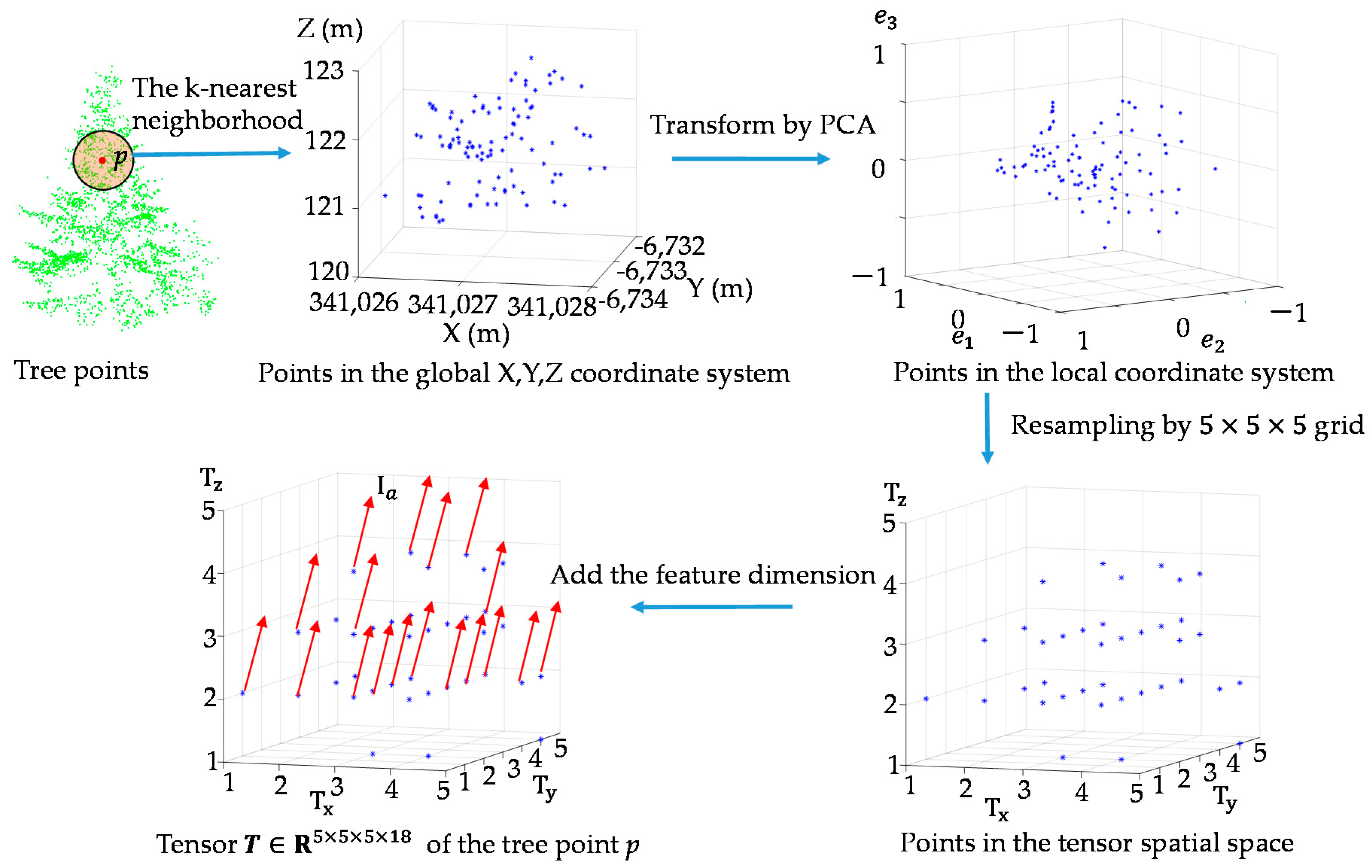

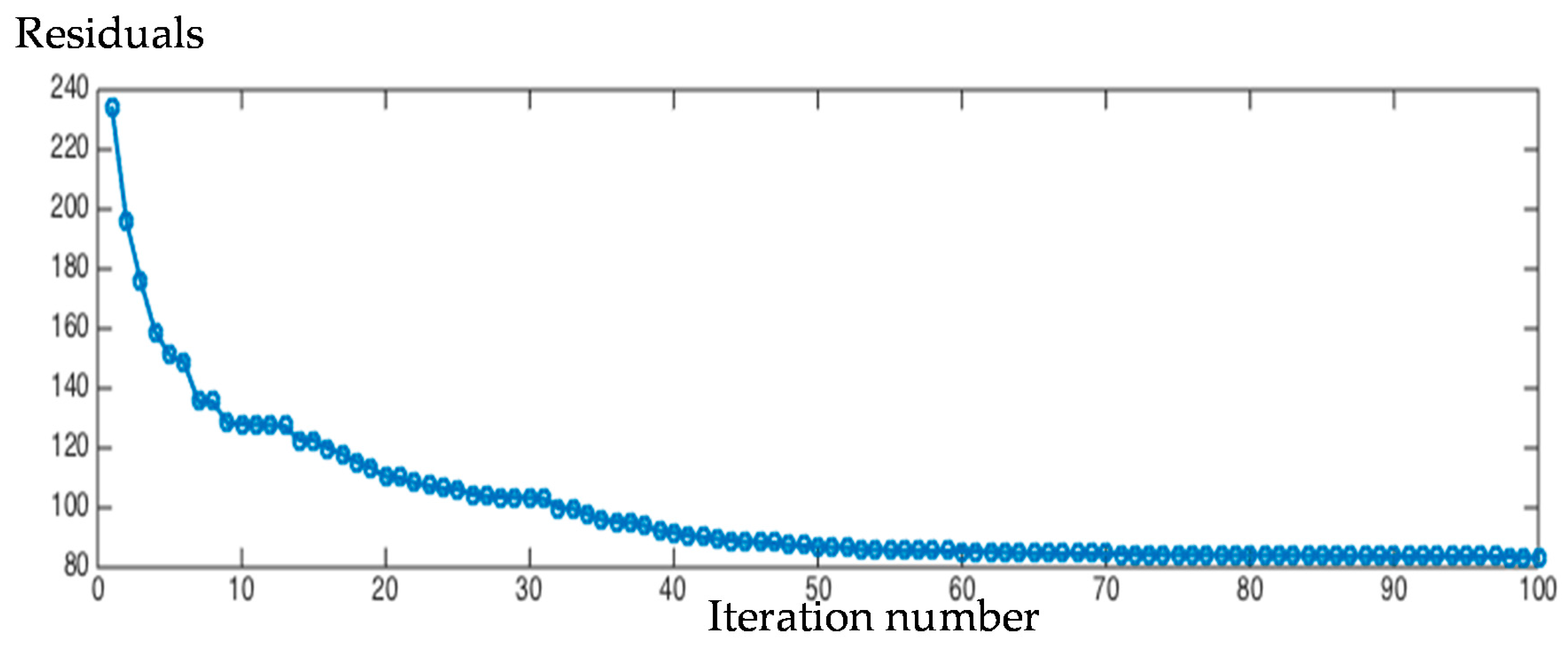
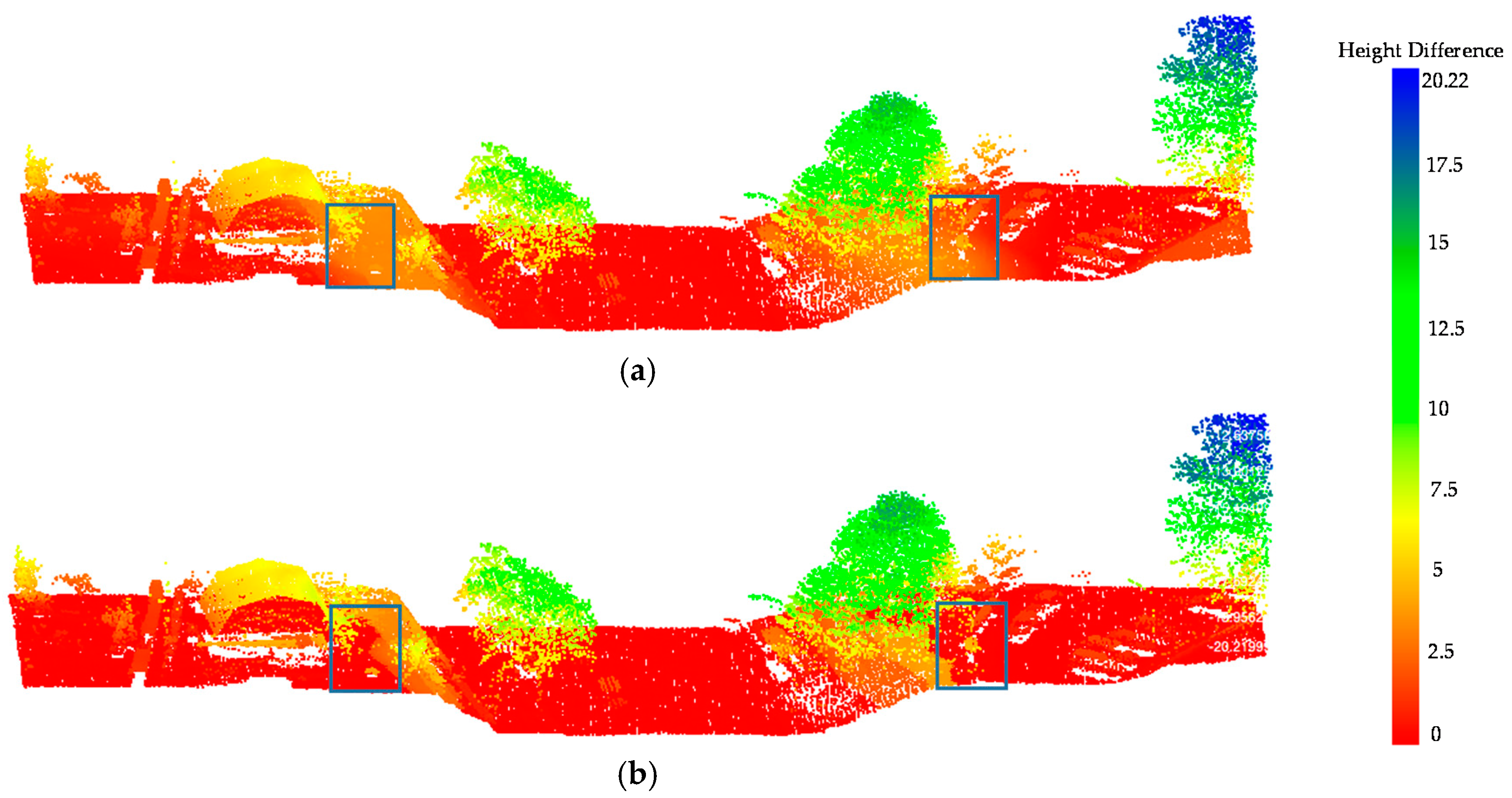

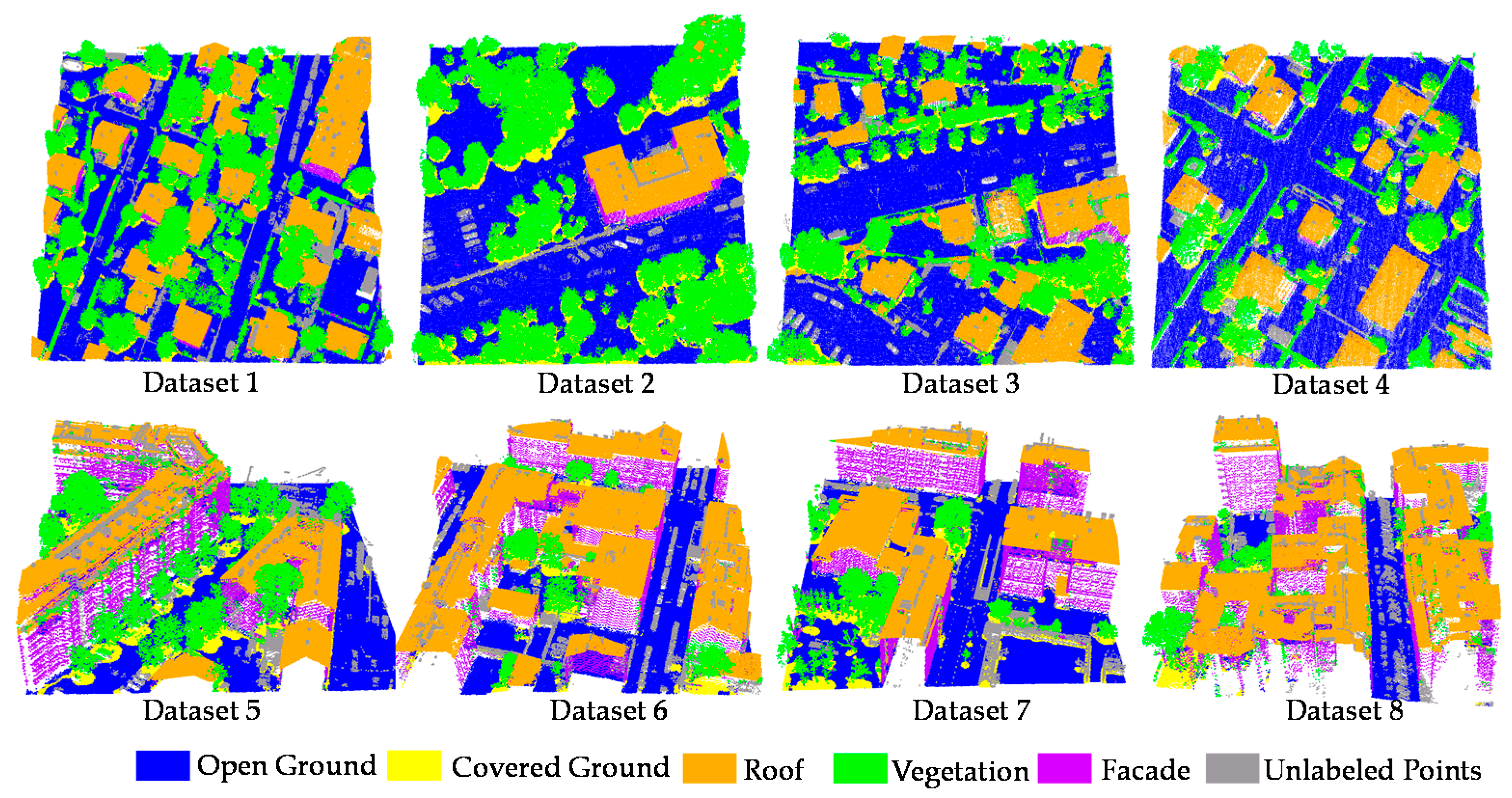

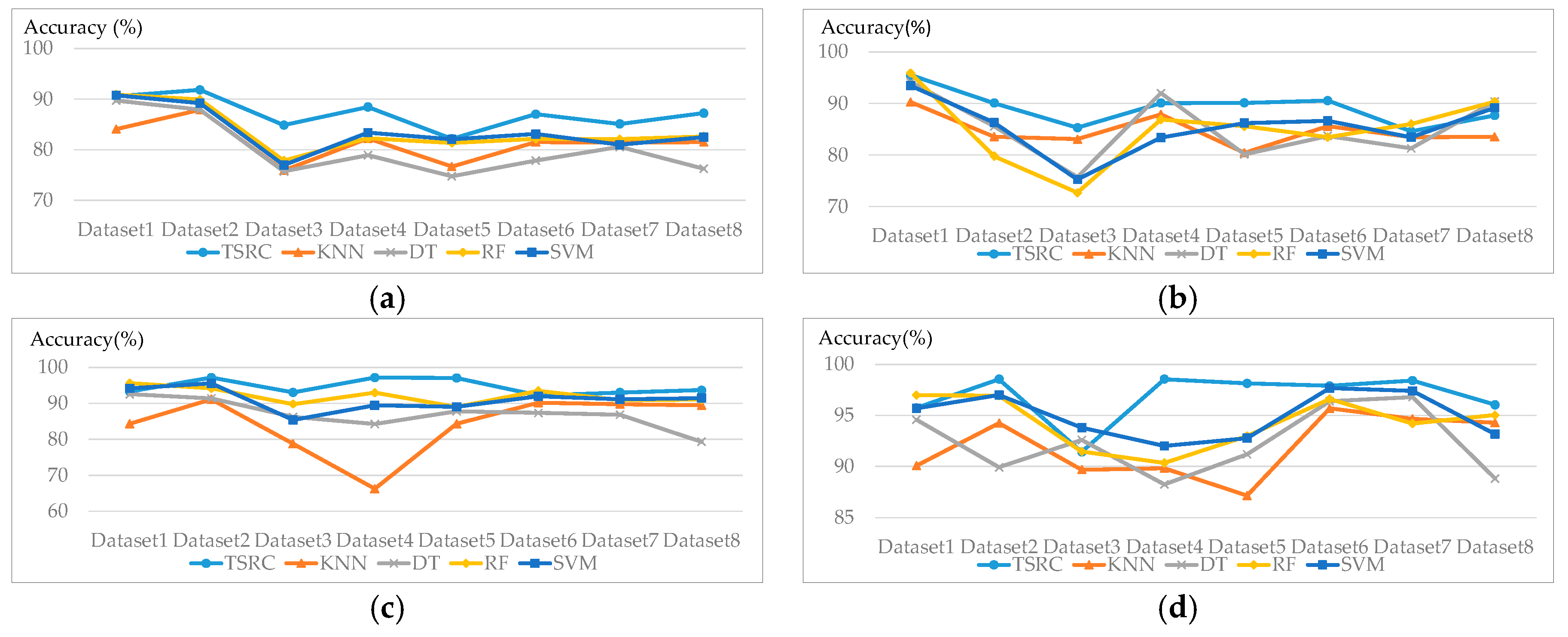

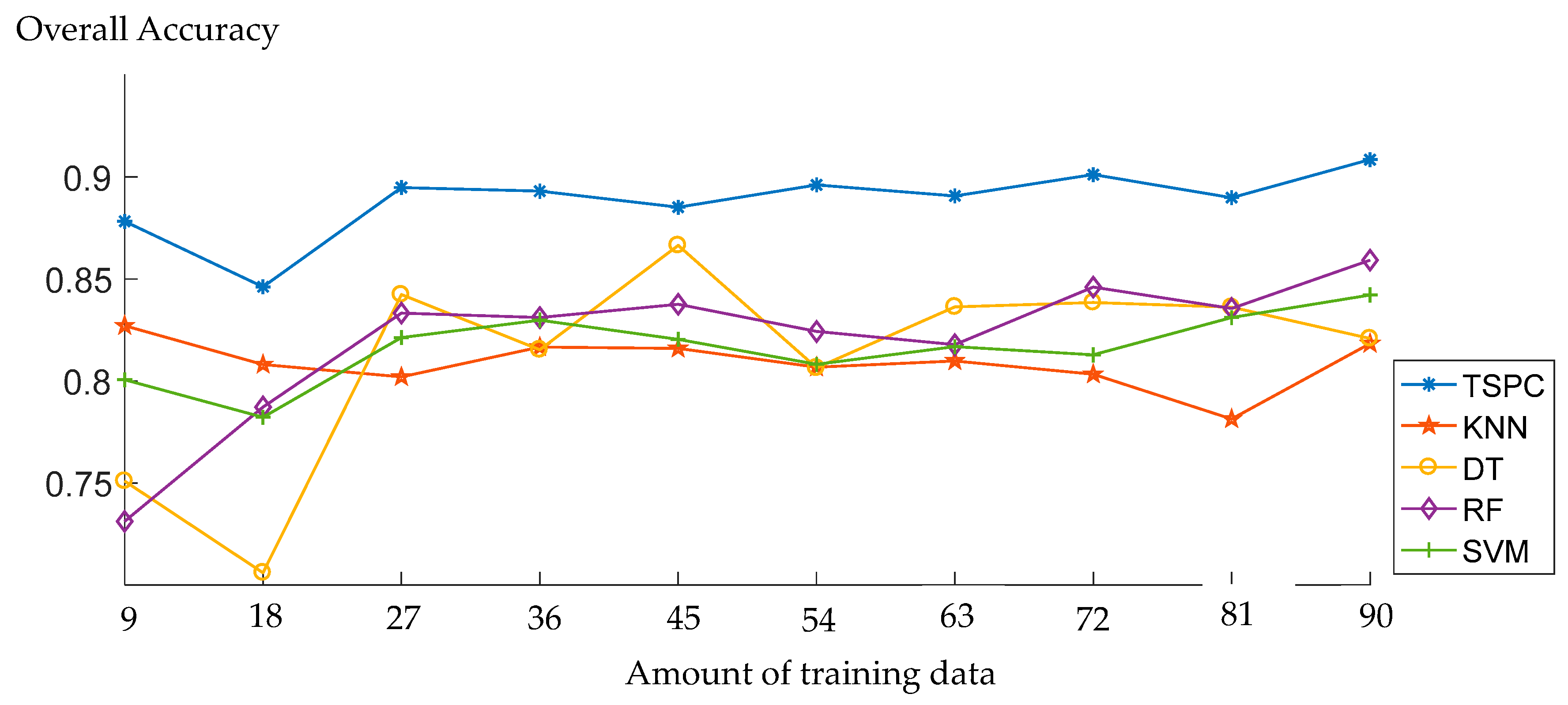
| Algorithm: Tensor OMP |
| Require: input point tensor Dictionaries , , , maximum number of non-zeros coefficients in each mode. |
| Output: sparse tensor non-zeros coefficients index in sparse tensor |
| Step: 1, initial: , Residual , , k = 0, |
| 2, while do |
| 3, |
| 4, (). (:), (:,), (:,), (:,); |
| 5, ; 6, |
| 7, ; |
| 8, t = t + 1; |
| 9, end while |
| 10, return , . |
| Dataset | Test Set | Training Set | Mean OA | OA std.dev | Data Set | Test Set | Training Set | Mean OA | OA std.dev |
|---|---|---|---|---|---|---|---|---|---|
| Dataset 1 | 665,466 | 0.02% | 90.57% | 0.77% | Dataset 5 | 365,926 | 0.03% | 82.16% | 0.69% |
| Dataset 2 | 452,800 | 0.02% | 91.85% | 0.84% | Dataset 6 | 222,702 | 0.06% | 87.03% | 0.71% |
| Dataset 3 | 352,318 | 0.03% | 84.98% | 0.63% | Dataset 7 | 880,809 | 0.02% | 85.09% | 0.91% |
| Dataset 4 | 298,201 | 0.04% | 88.44% | 0.89% | Dataset 8 | 320,716 | 0.04% | 87.24% | 0.64% |
| Reference Class | ||||||||
|---|---|---|---|---|---|---|---|---|
| Predicted Class | Dataset | Open Ground | Vegetation | Roof | Covered Ground | Facade | Total Points | Training Points |
| Open ground | Dataset 1 | 89.34% | 0.87% | 0.97% | 8.59% | 0.13% | 255,835 | 27 |
| Dataset 2 | 90.07% | 0.04% | 0% | 9.86% | 0.02% | 193,715 | 27 | |
| Dataset 3 | 85.3% | 1.39% | 4.45% | 8.83% | 0.03% | 188,776 | 27 | |
| Dataset 4 | 91.69% | 1.95% | 0.58% | 5.68% | 0.1% | 124,024 | 27 | |
| Dataset 5 | 90.11% | 0.51% | 0.02% | 9.31% | 0.04% | 148,164 | 27 | |
| Dataset 6 | 84.59% | 0.08% | 0.83% | 14.44% | 0.04% | 413,762 | 27 | |
| Dataset 7 | 87.68% | 0.33% | 2.67% | 9.09% | 0.22% | 104,853 | 27 | |
| Dataset 8 | 90.53% | 0.004% | 0.007% | 9.06% | 0.4% | 55,223 | 27 | |
| Vegetation | Dataset 1 | 1.02% | 94.21% | 1.57% | 1.85% | 1.35% | 157,013 | 27 |
| Dataset 2 | 0.83% | 97.16% | 1.14% | 0.73% | 0.15% | 148,961 | 27 | |
| Dataset 3 | 0.97% | 93.03% | 3.33% | 1.56% | 1.11 | 65,191 | 27 | |
| Dataset 4 | 1.53% | 94.39% | 1.66% | 1.41% | 1.01% | 35,545 | 27 | |
| Dataset 5 | 0.24% | 97.02% | 0.22% | 1.22% | 1.3% | 34,462 | 27 | |
| Dataset 6 | 0.98% | 93.01% | 0.86% | 3.48% | 1.67% | 57,892 | 27 | |
| Dataset 7 | 1.16% | 93.65% | 0.75% | 2.19% | 2.25% | 15,905 | 27 | |
| Dataset 8 | 1.09% | 92.19% | 1.8% | 2.34% | 2.57% | 20,949 | 27 | |
| Roof | Dataset 1 | 0.49% | 2.63% | 96.13% | 0.26% | 0.48% | 144,671 | 27 |
| Dataset 2 | 0.02% | 1.16% | 98.55% | 0.15% | 0.11% | 26,430 | 27 | |
| Dataset 3 | 1.77% | 5.88% | 91.42% | 0.59% | 0.34% | 45,955 | 27 | |
| Dataset 4 | 0.14% | 6.52% | 92.86% | 0.2% | 0.28% | 36,137 | 27 | |
| Dataset 5 | 0.18% | 1.19% | 98.14% | 0.07% | 0.41% | 72,738 | 27 | |
| Dataset 6 | 0.66% | 0.38% | 98.41% | 0.31% | 0.24% | 248,716 | 27 | |
| Dataset 7 | 0.7% | 1.94% | 96.05% | 0.34% | 0.97% | 112,417 | 27 | |
| Dataset 8 | 0.42% | 0.17% | 97.9% | 0.17% | 1.35% | 164,376 | 27 | |
| Covered ground | Dataset 1 | 4.47% | 0.99% | 0.16% | 94.33% | 0 | 53,491 | 27 |
| Dataset 2 | 1.98% | 1.27% | 0.01% | 96.71% | 0.02% | 64,778 | 27 | |
| Dataset 3 | 8.65% | 1.69% | 0.81% | 88.8% | 0.04% | 31,373 | 27 | |
| Dataset 4 | 5.11% | 0.57% | 0.02% | 94.09% | 0.21% | 13,910 | 27 | |
| Dataset 5 | 7.78% | 2.06% | 0 | 90.16% | 0.003% | 31,186 | 27 | |
| Dataset 6 | 1.4% | 1.37% | 0.24% | 96.99% | 0.008% | 49,481 | 27 | |
| Dataset 7 | 3.35% | 0.63% | 0.14% | 95.88% | 0 | 11,000 | 27 | |
| Dataset 8 | 4.41% | 0.008% | 0 | 95.52% | 0.05% | 11,127 | 27 | |
| Facade | Dataset 1 | 1.71% | 9.61% | 4.96% | 1.69% | 82.02% | 13,707 | 27 |
| Dataset 2 | 3.45% | 1.89% | 1.84% | 1.84% | 90.97% | 6,189 | 27 | |
| Dataset 3 | 0.08% | 18.77% | 0.5% | 0.92% | 79.73% | 4,787 | 27 | |
| Dataset 4 | 4.68% | 10.52% | 0.65% | 1.56% | 82.60% | 2,313 | 27 | |
| Dataset 5 | 1.09% | 12.01% | 10.49% | 0.36% | 76.06% | 37,636 | 27 | |
| Dataset 6 | 1.57% | 4.14% | 8.9% | 0.53% | 84.85 | 47,506 | 27 | |
| Dataset 7 | 0.94% | 6.25% | 4.07% | 1.01% | 87.73% | 24,852 | 27 | |
| Dataset 8 | 0.76% | 5.22% | 6.92% | 0.25% | 86.84% | 40,815 | 27 | |
| Dataset | Mean OA | OA std.dev | ||||||||
|---|---|---|---|---|---|---|---|---|---|---|
| TSRC | KNN | DT | RF | SVM | TSRC | KNN | DT | RF | SVM | |
| Dataset 1 | 90.57% | 84.06% | 89.72% | 90.93% | 90.15% | 0.77% | 1.07% | 0.89% | 0.77% | 0.68% |
| Dataset 2 | 91.85% | 87.88% | 87.91% | 89.91% | 89.20% | 0.84% | 1.34% | 1.94% | 1.19% | 0.91% |
| Dataset 3 | 84.98% | 75.90% | 75.72% | 77.87% | 76.98% | 0.63% | 1.58% | 2.46% | 1.81% | 1.63% |
| Dataset 4 | 88.44% | 82.21% | 78.93% | 82.25% | 83.36% | 0.89% | 1.53% | 2.53% | 1.73% | 2.17% |
| Dataset 5 | 82.16% | 76.68% | 74.75% | 81.34% | 82.07% | 0.69% | 0.84% | 1.83% | 2.81% | 0.67% |
| Dataset 6 | 87.03% | 81.53% | 77.85% | 82.14% | 83.11% | 0.71% | 1.66% | 2.84% | 1.72% | 1.77% |
| Dataset 7 | 85.09% | 81.37% | 80.55% | 82.10% | 80.99% | 0.91% | 1.70% | 2.67% | 1.32% | 1.61% |
| Dataset 8 | 87.24% | 81.52% | 76.23% | 82.63% | 82.48% | 0.64% | 1.19% | 2.48% | 1.53% | 1.24% |
| kt | 20 | 40 | 60 | 80 | 100 | 120 |
|---|---|---|---|---|---|---|
| Open Ground | 91.13% | 88.62% | 92.81% | 88.52% | 93.07% | 90.65% |
| Vegetation | 85.11% | 93.07% | 90.13% | 91.79% | 91.31% | 86.91% |
| Roof | 92.98% | 89.35% | 91.77% | 93.65% | 94.08% | 92.16% |
| Covered ground | 93.00% | 96.82% | 93.37% | 97.07% | 90.84% | 96.45% |
| Facade | 68.86% | 73.93% | 78.57% | 83.63% | 85.38% | 93.3% |
| OA | 86.83% | 86.69% | 89.27% | 87.75% | 90.39% | 88.39% |
| Kappa Index | 0.7946 | 0.7925 | 0.8327 | 0.809 | 0.8502 | 0.8189 |
| 5 | 7 | 9 | 11 | 13 | 15 | 17 | 18 | |
|---|---|---|---|---|---|---|---|---|
| Open Ground | 91.36% | 91.76% | 92.13% | 92.29% | 92.43% | 91.36% | 92.42% | 92.52% |
| Vegetation | 92.44% | 92.42% | 92.21% | 92.06% | 91.55% | 92.44% | 86.67% | 85.77% |
| Roof | 95.44% | 95.48% | 95.47% | 95.70% | 95.44% | 95.44% | 95.76% | 95.56% |
| Covered ground | 95.17% | 94.25% | 93.73% | 93.35% | 93.24% | 95.17% | 92.5% | 92.09% |
| Facade | 86.49% | 86.75% | 88.7% | 88.7% | 85.71% | 86.49% | 81.82% | 81.82% |
| OA | 89.50% | 89.69% | 89.85% | 89.92% | 89.94% | 89.49% | 89.14% | 89.01% |
| Kappa Index | 0.8363 | 0.8392 | 0.8418 | 0.8428 | 0.8431 | 0.8361 | 0.8306 | 0.8286 |
© 2017 by the authors. Licensee MDPI, Basel, Switzerland. This article is an open access article distributed under the terms and conditions of the Creative Commons Attribution (CC BY) license (http://creativecommons.org/licenses/by/4.0/).
Share and Cite
Li, N.; Pfeifer, N.; Liu, C. Tensor-Based Sparse Representation Classification for Urban Airborne LiDAR Points. Remote Sens. 2017, 9, 1216. https://doi.org/10.3390/rs9121216
Li N, Pfeifer N, Liu C. Tensor-Based Sparse Representation Classification for Urban Airborne LiDAR Points. Remote Sensing. 2017; 9(12):1216. https://doi.org/10.3390/rs9121216
Chicago/Turabian StyleLi, Nan, Norbert Pfeifer, and Chun Liu. 2017. "Tensor-Based Sparse Representation Classification for Urban Airborne LiDAR Points" Remote Sensing 9, no. 12: 1216. https://doi.org/10.3390/rs9121216




